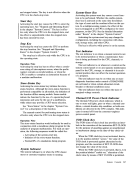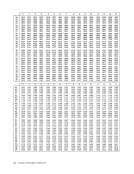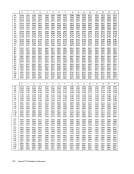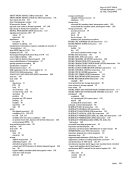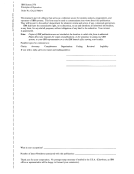specified by the current CCW may be prefetched
and buffered. When data chaining during an output
operation, the channel may fetch the next CCW at
any time during the execution of the current CCW.
When theI/O operation uses data and CCWs from
locations near the end of the available storage, such
pre fetching may cause the channel to refer to loca
tions that do not exist. Invalid addresses detected
during prefetching of data or CCWs do not affect
the execution of the operation and do not cause er
ror indications until theI/O operation actually at tempts to use the information. If the operation is
concluded by theI/O device or by HALT I/O, HALT DEVICE, or CLEAR I/O before the invalid
information is needed, the condition is not brought
to the attention of the program.
The count field in the CCW can specify anynum ber of bytes up to 65,535. Except for a CCW specify ing transfer in channel, where the count field is
ignored, the count field may not contain the value
zero. Whenever the count field in the CCW initially
contains a zero, the program-check condition is gen
erated. When this occurs in the first CCW designat
ed by the CAW, the operation is not initiated, and
the status portion of the CSW with the program
check indication is stored during execution ofST ART I/O or START I/O FAST RELEASE being
executed as STARTI/O. When a count of zero is
detected during data chaining, theI/O device is sig
naled to terminate the operation. Detection of acount of zero during command chaining or subse quent to the execution of ST ART I/O FAST RE LEASE suppresses initiation of the new operation
and generates an interruption condition.
Chaining
When the channel has performed the transfer of
information specified by a CCW, it can continue the
activity initiated by STARTI/O or START I/O FAST RELEASE by fetching a new CCW. Such
fetching of a new CCW is called chaining, and the
CCWs belonging to such a sequence are said to be
chained.
Chaining takes place
successive double word locations in storage. It pro
ceeds in an ascending order of addresses; that is, the
address of the new CCW is obtained by adding eight
to the address of the current CCW. Two chains of
CCWs located in noncontiguous storage areas can
be coupled for chaining purposes by a transfer-in
channel command. All CCW s in a chain apply to theI/O device specified in the original START I/O or
STARTI/O FAST RELEASE.
Two types of chaining are provided: chaining of
data and chaining of commands. Chaining is con-
trolled by the chain-data (CD) and chain-command
(CC) flags in conjunction with the suppress-length
indication (SLI) flag in the CCW. These flags speci
fy the action to be taken by the channel upon the
exhaustion of the current CCW and upon receipt of
ending status from the device, as shown in theac companying table.
The specification of chaining is effectivelypropa gated through a transfer-in-channel command. When
in the process of chaining a transfer-in-channelcom mand is fetched, the CCW designated by the trans fer in channel is used for the type of chaining speci
fied in the CCW preceding the transfer-in-channel.
The CD and CC flags are ignored in thetransfer in-channel command.
Data Chaining
During data chaining, the new CCW fetched by the
channel defines a new storage area for the originalI/O operation. Execution of the operation at the I/O device is not affected. When all data designated
by the current CCW has been transferred to main
storage or to the device, data chaining causes the
operation to continue, using the storage areadesig nated by the new CCW. The contents of the
command-code field of the new CCW are ignored,
unless they specify transfer in channel.
Data chaining is considered to occur immediately
after the last byte of data designated by the current
CCW has been transferred to main storage or to the
device. When the last byte of the transfer has been
placed in main storage or accepted by the device, the
new CCW takes over the control of the operation
and replaces the pertinent information in the sub
channel. If the device sends channel end after ex
hausting the count of the current CCW but before
transferring any data to or from the storage area
designated by the new CCW, the CSW associated
with the concluded operation pertains to the new
CCW.
If programming errors are detected in the new
CCW or during its fetching, the error indication is
generated, and the device is signaled to conclude the
operation when it attempts to transfer data designat
ed by the new CCW. If the device signals the
channel-end condition before transferring any data
designated by the new CCW, program check orpro tection check is indicated in the CSW associated
with the termination. The contents of the CSW per
tain to the new CCW unless the address of the new
CCW is invalid, the location is protected against
fetching, or programming errors are detected in an
intervening transfer-in-channel command. A data
Input/Output Operations 213
and buffered. When data chaining during an output
operation, the channel may fetch the next CCW at
any time during the execution of the current CCW.
When the
locations near the end of the available storage, such
pre fetching may cause the channel to refer to loca
tions that do not exist. Invalid addresses detected
during prefetching of data or CCWs do not affect
the execution of the operation and do not cause er
ror indications until the
concluded by the
information is needed, the condition is not brought
to the attention of the program.
The count field in the CCW can specify any
ignored, the count field may not contain the value
zero. Whenever the count field in the CCW initially
contains a zero, the program-check condition is gen
erated. When this occurs in the first CCW designat
ed by the CAW, the operation is not initiated, and
the status portion of the CSW with the program
check indication is stored during execution of
executed as START
detected during data chaining, the
naled to terminate the operation. Detection of a
and generates an interruption condition.
Chaining
When the channel has performed the transfer of
information specified by a CCW, it can continue the
activity initiated by START
fetching of a new CCW is called chaining, and the
CCWs belonging to such a sequence are said to be
chained.
Chaining takes place
successive double word locations in storage. It pro
ceeds in an ascending order of addresses; that is, the
address of the new CCW is obtained by adding eight
to the address of the current CCW. Two chains of
CCWs located in noncontiguous storage areas can
be coupled for chaining purposes by a transfer-in
channel command. All CCW s in a chain apply to the
START
Two types of chaining are provided: chaining of
data and chaining of commands. Chaining is con-
trolled by the chain-data (CD) and chain-command
(CC) flags in conjunction with the suppress-length
indication (SLI) flag in the CCW. These flags speci
fy the action to be taken by the channel upon the
exhaustion of the current CCW and upon receipt of
ending status from the device, as shown in the
The specification of chaining is effectively
in the process of chaining a transfer-in-channel
fied in the CCW preceding the transfer-in-channel.
The CD and CC flags are ignored in the
Data Chaining
During data chaining, the new CCW fetched by the
channel defines a new storage area for the original
by the current CCW has been transferred to main
storage or to the device, data chaining causes the
operation to continue, using the storage area
command-code field of the new CCW are ignored,
unless they specify transfer in channel.
Data chaining is considered to occur immediately
after the last byte of data designated by the current
CCW has been transferred to main storage or to the
device. When the last byte of the transfer has been
placed in main storage or accepted by the device, the
new CCW takes over the control of the operation
and replaces the pertinent information in the sub
channel. If the device sends channel end after ex
hausting the count of the current CCW but before
transferring any data to or from the storage area
designated by the new CCW, the CSW associated
with the concluded operation pertains to the new
CCW.
If programming errors are detected in the new
CCW or during its fetching, the error indication is
generated, and the device is signaled to conclude the
operation when it attempts to transfer data designat
ed by the new CCW. If the device signals the
channel-end condition before transferring any data
designated by the new CCW, program check or
with the termination. The contents of the CSW per
tain to the new CCW unless the address of the new
CCW is invalid, the location is protected against
fetching, or programming errors are detected in an
intervening transfer-in-channel command. A data
Input/Output Operations 213
























































































































































































































































